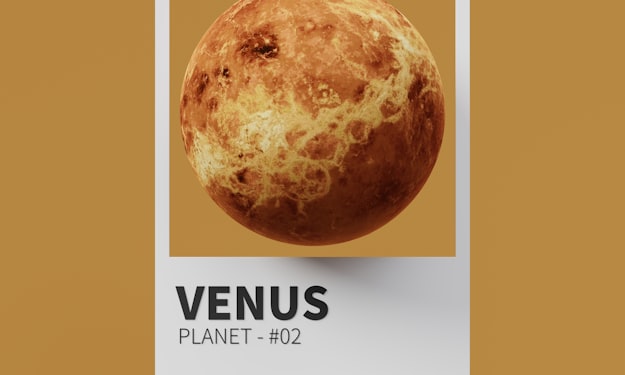history
The history of technology and technology throughout history; human innovation from the first stone tool to the iPhone and beyond.


Top 10 rackets with world famous players
1. Babolat Pure Aero: Babolat Pure Aero is a favorite of both professional and recreational players. With Aeromodular technology for enhanced maneuverability and spin, this racquet delivers impressive power and control right from the baseline. Its sleek design and comfortable feel make it a popular choice for players of all levels.
Nguyễn Bảo QuốcPublished 3 days ago in 01Venus Loses Oxygen: BepiColombo Reveals Atmosphere Escape
Venus: Earth's Scorching Sister Planet Venus, our closest planetary neighbor, is a terrestrial world shrouded in mystery. Similar in size and mass to Earth, it's often called Earth's twin. However, unlike our blue marble, Venus boasts a scorching atmosphere thick with carbon dioxide, creating a runaway greenhouse effect that makes it the hottest planet in the solar system. This dense atmosphere, laced with sulfuric acid clouds, hides a volcanic surface scarred by lava flows and towering mountains. Though currently hostile, scientists wonder if Venus might have held oceans and a more hospitable climate in its distant past.


Six Memory
The main image is by the wonderful Rebecca Cother. Introduction This is piece that I posted on the 29th of July 2018 and thanks to Facebook reminders I knew it was the birthday of six people. Ift got me thinking of how we use technology to remember things for us.
Mike Singleton - MikeydredPublished 5 days ago in 01

Unveiling the Ancient Beauty Secrets:
Unveiling the Ancient Beauty Secrets: Exploring the World's Oldest Cosmetics In the modern era, cosmetics play a significant role in enhancing beauty and confidence. However, the concept of cosmetics is not a recent development; it dates back thousands of years. Delving into the annals of history unveils a fascinating world of ancient beauty secrets and rituals. From ancient civilizations to distant cultures, cosmetics have been an integral part of human civilization since time immemorial. In this article, we embark on a journey to explore the world's oldest cosmetics, unraveling the mysteries behind their formulations, usage, and cultural significance.
Chuckle counselorPublished 10 days ago in 01

The Knowledgeable Application of Display Packaging in Building Brands
As a business owner, you must be aware that packaging is more than a means of safety. Custom Display Boxes are an excellent choice to enhance branding efforts. The key purpose of brands is to present their products in an attractive way. Display packaging did this job very well. These boxes add appeal to product showcasing and convey the brand message to the world. It is a game-changer for your brand and maximizes product sales. Do you want to give more visibility to perfectly designed products? Get countertop display packaging to become prominent on shelves. These are the most attention-grabber packaging solutions for any brand. Not only this, but you will also get financial benefits from such packaging. However, there is a need to use these boxes in an excellent way to see their full potential.
Jesse RowanPublished 16 days ago in 01Living on Video / Trans X
Nothing dates as fast as someone else’s idea of the future. Back in the day, Trans X seemed like a glimpse of life in the unimaginably sci-fi year 2000. From synth sounds to hi-tech visuals, this was music destined to make an impression on an 80s schoolboy.
Andy PottsPublished 20 days ago in 01"One of the greatest speeches of all time | Steve Jobs"
Steve Jobs, the visionary co-founder of Apple Inc., left behind a legacy that transcends the realm of technology. Beyond revolutionizing industries, his life was punctuated by pivotal moments that encapsulated the essence of resilience, innovation, and the pursuit of passion. In this article, we unravel three poignant stories from Jobs' life, each brimming with profound insights and timeless wisdom.
Harry NguyenPublished 21 days ago in 01

More Shopping Malls Coming Up in Top Cities?
Introduction Of Shopping Complex Coming Up in Top Cities: In recent times, the skylines of top cities have undergone a spectacular transformation, marked by a surge in the construction of larger and more sophisticated shopping malls.
oree realityPublished 21 days ago in 01

Ultra Food
Ultra-processed meals have completely taken over fast-food menus and supermarket aisles in our current era of convenience. These goods, which are frequently enticing and handy, beg the important question: Are foods that have undergone extensive processing actually bad for our health? The discussion on how they affect wellbeing is complex and involves dietary choices, public health campaigns, and scientific studies. A thorough understanding of the complexity involved requires a thorough examination of the details surrounding ultra-processed foods and their possible effects on human health.
Nouman YousafPublished 25 days ago in 01The History of Memes
The term "internet meme" initially evoked annoyance, seemingly reducing cultural expression to a singular digital format. However, deeper exploration revealed a fascinating world of intricate and ever-evolving units shaping our digital landscape. What began as skepticism transformed into curiosity as the dynamics of meme culture unfolded. Memes serve as mirrors reflecting shared experiences and values, transcending language barriers to convey complex emotions and ideas. They encapsulate the essence of memetic design, competing for attention in the vast digital ecosystem. Understanding their significance offers insights into the collective psyche of online communities, guiding us in navigating the evolving digital landscape.
Sanjana DixitPublished 27 days ago in 01How Did Steve Jobs Invent The iPhone?
In the history of technological innovation, few products have left as indelible a mark on society as the iPhone. Launched in 2007, Apple's iconic smartphone redefined the way we communicate, work, and interact with technology. But the road to the iPhone's creation was far from smooth, marked by daunting challenges, relentless innovation, and personal sacrifices. This is the untold story of how the iPhone came to be - a tale of perseverance, ingenuity, and the transformative power of human ingenuity.
Sanjana DixitPublished 29 days ago in 01

Know More About the EEE PC
Let's delve into the realm of the ASUS EEE PC, a diminutive yet powerful computing marvel that has captivated the imagination of tech enthusiasts worldwide. Join us as we explore the intricacies of this compact laptop, driven by the potent PDA and brimming with delightful surprises at every turn. From its innovative design to its efficient performance, the ASUS EEE PC offers a unique blend of portability and functionality that continues to leave a lasting impression on users. Discover how this tiny powerhouse redefines the boundaries of mobile computing and sets new standards for compact yet capable devices in the tech industry.
Sanjana DixitPublished about a month ago in 01

















